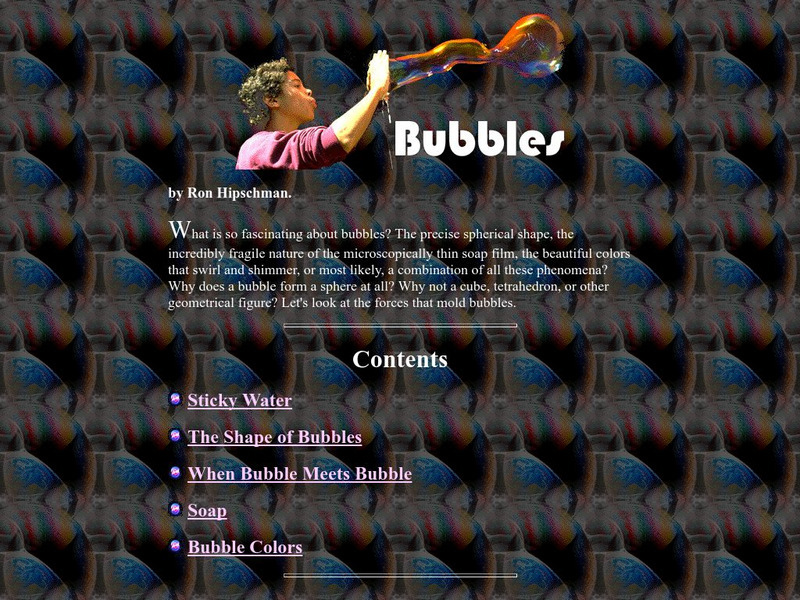Hi, what do you want to do?
Curated OER
Experiment: How acidic is rain in your area?
High schoolers collect water samples from around your home and school, check the pH level of each water sample, and record the pH levels in a chart that looks something like this:
Curated OER
Water Quality and Temperature
Students evaluate the effects of temperature changes on the metabolic rate of a clam. Conclusion questions are addressed which help students to process and articulate their experiences.
Curated OER
Water and Me
Young scholars name the ways in which they use water every day and create a counting book using the ways in which they use water to illustrate it. The measure and graph the amount of water they use when they wash their hands.
Curated OER
DNA Extraction From a Variety of Tissue Samples
Learners, working in cooperative groups, extract very impure samples of DNA from a number of tissue samples. They determine how the samples can be preserved and how they are similar.
Curated OER
Agriculture Counts
Students focus upon the agricultural economy found in Oklahoma. Upon the completion of research they write an essay with the topic of "Agriculture Counts". The lesson plan includes an extensive introduction for teachers and students to...
Curated OER
You are the Microbiologist
In this activity, learners demonstrate comprehension of basic lab techniques by properly using these techniques in preparing a laboratory investigation, demonstrate synthesis of prior lab experiences by solving a new problem using those...
Curated OER
Not Just For A Baby's Bottom
Eighth graders investigate the presence of talc in the geologic record. The different characteristics of talc is covered. The lesson plan includes background information for the teacher.
Curated OER
Jingle Bell Jog
Learners explore the connection between doing something positive for people in need. They ask family, friends, and neighbors to be sponsors for a jog/walk-a-thon. Patrons donate a specific number of non-perishable items for each lap the...
Curated OER
Integrated Social Studies Lesson and Science Lesson
Fourth graders discuss the Civil War and the fact that many soldiers died during the war as a result of sickness. They discuss germs and participate in an activity that shows them how germs are spread and how they can be stopped from...
Curated OER
Wacky Water Critters
Young scholars recognize the biodiversity that exists in a wetland ecosystem. They identify individual wetland organisms. Students define, identify, and comprehend the importance of adaptations. They describe the process of...
Curated OER
Wanted: The Infamous Five
Students name the five most common types of foodborne pathogens. They comprehend how bacteria can grow and spread. Students are taught healthy hygiene and food-safety habits. They discuss the crimes of the five most wanted foodborne...
Curated OER
Back To School Crossword
In this reading worksheet, learners analyze 10 words which pertain to Back to school time. Students read clues and fit the words in the crossword puzzle.
Curated OER
Summer Water & Sand Activity: Go with the Flow
Learners discover different materials that help to transport water in order to develop their observation and problem solving science skills. In this water lesson, students first brainstorm about different ways that water can be moved;...
Curated OER
Uses of Pumice
In this pumice instructional activity, students read about how pumice if formed and the different uses of pumice. Then students complete 4 short answer questions
Curated OER
Ocean Pollution
Students study their role in eliminating ocean pollution and helping keep the oceans clean. In this environmental issues activity, students define pollution and brainstorm examples of ocean pollution. Students define biodegradable and...
Curated OER
Introduce Vocabulary: Annabelle Swift, Kindergartner
Young scholars explore language arts by reading a book about children. In this tier two vocabulary activity, students read the book Annabelle Swift, Kindergartner and identify the use of specific vocabulary words. Young scholars define...
Other
Gary Olds Art and Fine Craft: Colonial Soap Making: Its History and Techniques
This article by Marietta and Arthur Ellis describes the history of soap-making. Scroll through to find reference to colonial soap-making history and techniques. [PDF]
Read Works
Read Works: Special Soap
[Free Registration/Login Required] A literary text about a boy named Ethan whose father teaches him how to make environmentally friendly laundry soap. A question sheet is available to help students build skills in reading comprehension.
Children's Discovery Museum
Children's Discovery Museum of San Jose: Soap Bubbles
Bubble solution is easy to make and provides endless fun. Experiment using different materials to make good bubble makers.
Exploratorium
Exploratorium: Science Snacks: Soap Bubble Shapes
Using straws and soap, you can create geometric shapes to make a colorful art display when light shines through them.
PBS
Pbs: Rough Science
Website companion to PBS show, "Rough Science," in which five scientists use their collective expertise to complete a series of tasks. Follow the scientists as they do things like generate electricity, make soap, make antibacterial...
Exploratorium
Exploratorium: Soap Bubbles
A scientific look at soap bubbles. Find out what it is about soap and water that allows bubbles to occur, how bubbles stick to each other, and why they are always a sphere. There are even formulae for making your own bubble solution.
Starfall
Starfall: Make a Word: Two Vowels
Interactive games that allow you to create a word to match the picture cues. Vowel teams: ai, ea, oa. Long vowel words: mail, rain, seal, team, boat, soap.
Science Education Resource Center at Carleton College
Serc: Mn Step: Surface Tension With Soap Film
An investigation into the effect soap has on the surface tension of water. Learners create three-dimensional shapes using toothpicks and clay, dip them into soapy water, and make observations and formulate questions about the soap film.


























